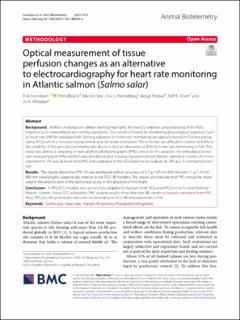| dc.contributor.author | Svendsen, Eirik | |
| dc.contributor.author | Økland, Finn | |
| dc.contributor.author | Føre, Martin | |
| dc.contributor.author | Randeberg, Lise Lyngsnes | |
| dc.contributor.author | Finstad, Bengt | |
| dc.contributor.author | Olsen, Rolf Erik | |
| dc.contributor.author | Alfredsen, Jo Arve | |
| dc.date.accessioned | 2022-08-09T10:40:40Z | |
| dc.date.available | 2022-08-09T10:40:40Z | |
| dc.date.created | 2021-10-06T12:42:15Z | |
| dc.date.issued | 2021 | |
| dc.identifier.citation | Animal Biotelemetry. 2021, 9 (41), 1-12. | en_US |
| dc.identifier.issn | 2050-3385 | |
| dc.identifier.uri | https://hdl.handle.net/11250/3010767 | |
| dc.description.abstract | Background: Welfare challenges in salmon farming highlights the need to improve understanding of the fish’s response to its environment and rearing operations. This can be achieved by monitoring physiological responses such as heart rate (HR) for individual fish. Existing solutions for heart rate monitoring are typically based on Electrocardiography (ECG) which is sensitive to placement and electrode orientation. These factors are difficult to control and affects the reliability of the principle, prompting the desire to find an alternative to ECG for heart rate monitoring in fish. This study was aimed at adapting an optical photoplethysmography (PPG) sensor for this purpose. An embedded sensor unit measuring both PPG and ECG was developed and tested using anesthetized Atlantic salmon in a series of in-vivo experiments. HR was derived from PPG and compared to the ECG baseline to evaluate its efficacy in estimating heart rate. Results: The results show that PPG HR was estimated with an accuracy of 0.7 ± 1.0% for 660 nm and 1.1 ± 1.2% for 880 nm wavelengths, respectively, relative to the ECG HR baseline. The results also indicate that PPG should be measured in the anterior part of the peritoneal cavity in the direction of the heart. Conclusion: A PPG/ECG module was successfully adapted to measure both ECG and PPG in-vivo for anesthetized Atlantic salmon. Using ECG as baseline, PPG analysis results show that that HR can be accurately estimated from PPG. Thus, PPG has the potential to become an alternative to ECG HR measurements in fish. | en_US |
| dc.language.iso | eng | en_US |
| dc.publisher | BMC | en_US |
| dc.rights | Navngivelse 4.0 Internasjonal | * |
| dc.rights.uri | http://creativecommons.org/licenses/by/4.0/deed.no | * |
| dc.subject | Photoplethysmography | en_US |
| dc.subject | Biosensors | en_US |
| dc.subject | Implant | en_US |
| dc.subject | Heart rate | en_US |
| dc.subject | Salmo salar | en_US |
| dc.title | Optical measurement of tissue perfusion changes as an alternative to electrocardiography for heart rate monitoring in Atlantic salmon (Salmo salar) | en_US |
| dc.type | Peer reviewed | en_US |
| dc.type | Journal article | en_US |
| dc.description.version | publishedVersion | en_US |
| dc.rights.holder | © The Author(s) 2021 | en_US |
| dc.source.pagenumber | 1-12 | en_US |
| dc.source.volume | 9 | en_US |
| dc.source.journal | Animal Biotelemetry | en_US |
| dc.source.issue | 41 | en_US |
| dc.identifier.doi | 10.1186/s40317-021-00264-w | |
| dc.identifier.cristin | 1943758 | |
| dc.relation.project | Norges forskningsråd: 280864 | en_US |
| cristin.ispublished | true | |
| cristin.fulltext | original | |
| cristin.qualitycode | 1 | |

